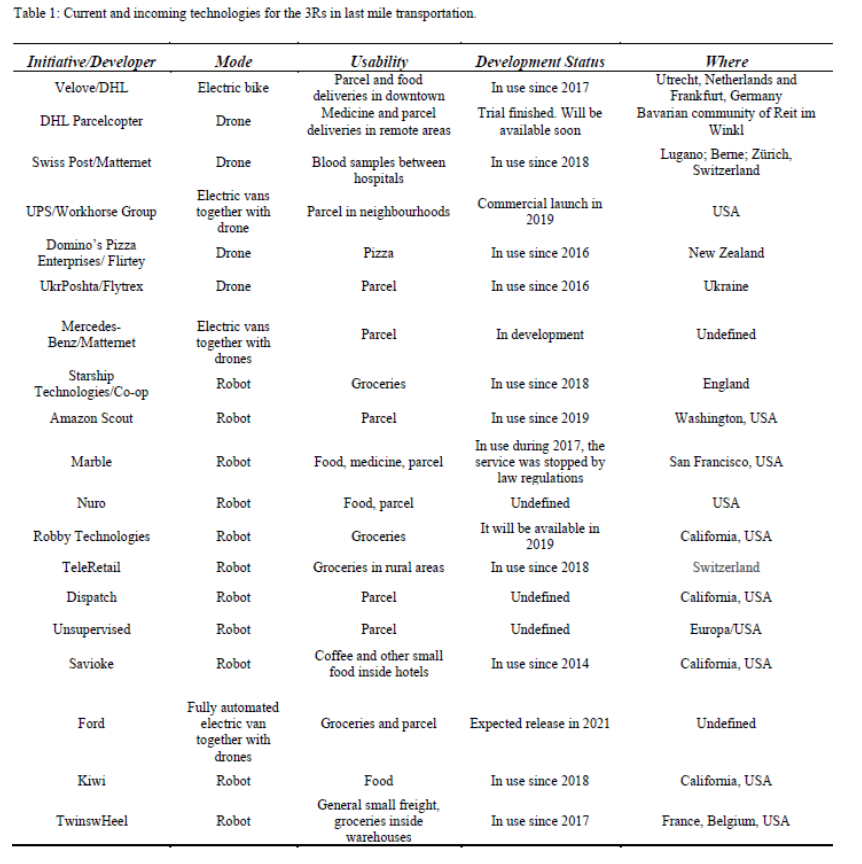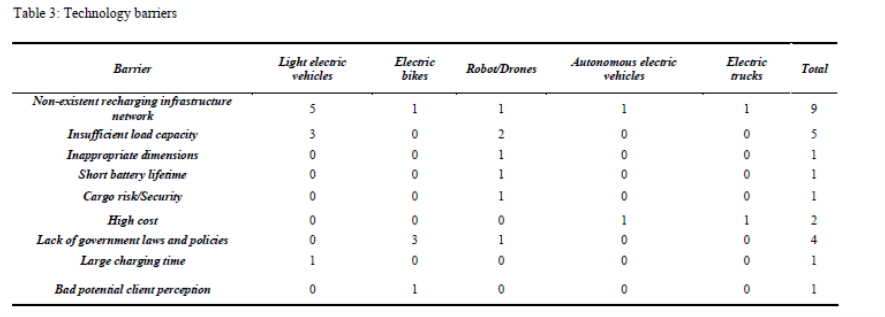
Researchers Carlos Otero-Palencia and Anmol Pahwa from the University of California and Miguel Jaller from the University of California and the Institute of Transportation Studies, published an article on Science Direct, regarding automation, electrification, and shared mobility (3Rs) in urban freight. Authors discuss the challenges and opportunities for the introduction of the 3Rs in the last mile. Here there are some of the key issues.
Everything that we consume or the materials used in manufacturing/industrial processes are brought by the urban freight system (UFS) The UFS includes the deliveries at the terminus of the supply chain, therefore, it deals with much more complex network environments. In the last mile, the customer could have specific delivery requirements.
Many factors make the transfer of goods inefficient, complex and expensive in the last mile. These include, but are not limited to, the availability of parking/staging areas; access to the building/store/house; readiness of the receiver (customer); availability of information systems; access to fueling/charging stations; safety/security requirements; type of commodity/shipment size/weight; and, delivery service/frequency, among others.
The electrification, automation, and shared mobility revolutions (3 Revolutions or 3Rs) stand as a promising alternative to improve the efficiency of last mile operations, considering the benefits that these have had for passenger transport; reduction of costs, times and carbon emissions. The arrival of these technologies is imminent, but there are still barriers that do not allow wide diffusion despite their potential benefits.
There are complexities in the system, the technologies themselves, and travel behavior trends that the research community is just beginning to grasp in light-duty passenger transport. There is more uncertainty about the impacts on the movement of goods.
The paper points out that the impacts for UFS are still unknown. There are few initiatives recently introduced to the market at a small scale, but little is known about the effect of its widespread use.
As is well known, automation initiatives that use robots and drones have had a strong growth in recent years, especially for retail and food deliveries. Most of these initiatives operate at a small scale today, even large companies such as Amazon limit their operations (Amazon only operates six small robots for doorstep deliveries or Amazon Scouts). This is because the uncertainties about federal and local regulations hamper additional investment, developments and testing. Even some current regulations limit the use of fully automated devices in public space, e.g.
In addition to the pilot tested technologies, the scientific literature has concentrated on the use of electric bikes and light electric vehicles as the most promising alternatives for the last mile. These vehicles are cheap, they do not require sophistication for their driving and are also at an important level of market readiness.
Electric bicycles show an important potential to reduce time, emissions and in some cases congestion. The literature highlights that these technologies have the potential to reduce logistics costs at a large scale, especially in the retail industry, where 24 of the 30 cases focused on retail, followed by the food industry with 3 cases. The greatest barrier found for the diffusion of these technologies is the lack of a network of recharging centers.
Another prevalent barrier is the limited load capacity, especially for light electric vehicles. This is an expected consequence of the reduction in the size of regular vehicles; however, it is expected that with the continuous development of these technologies the barrier will be overcome. Furthermore, one of the most important obstacles to the revolution of the last mile is the lack of laws that allow the movement of these vehicles on the streets.

Insights, directions and challenges for the incoming last mile revolutions
The researchers highlight that the arrival of electrification and automation technologies for the last mile is imminent. In fact, there are a variety of options already available. Many companies have already tested systems that went from the prototyping stage to be ready for use. As mentioned before, Amazon recently launched the Amazon Scouts. DHL is delivering cargo through electric cargo bikes in Germany and the Netherlands. The company also has a drone prototype almost ready to deliver parcels and medicine in remotes areas.
In the trucks and light vehicles arena, there are also important developments. In this field, manufacturers are most interested in fully automated vehicles for the long haul. Companies such as Daimler, Volvo, BYD, XOS, Cummins or Tesla are announcing the launch of their models for 2019 to 2022. However, there are some developments in the trials stage.
Despite these great technological developments, some barriers still do not allow the massive diffusion of these devices. Especially the lack of laws and policies that allow their free operation.

Regulatory environment and policies
Some initiatives have been restricted by regulations and laws. For example, four-wheel electric bicycles are restricted in the U.S. by Federal regulation. An electric bicycle will be regulated as a consumer product and may circulate as a conventional bicycle as long as it meets certain standards, for example, a limited operator weight of 170 pounds, a maximum of 3 wheels, and a top speed of 20 mph (National Conference of State Legislatures, 2019).
Other cases include the FAA regulations for drones, which limit their flights to no more than two miles, some other authorities require that the operator can observe the drone throughout the flight, which limits complete device autonomy.
The diversity of cargo types and environments could represent an additional challenge for authorities to determine what type of actions should be taken in case of eventualities.
Another concern revolves around privacy. Since drones are equipped with cameras, some people do not feel comfortable when these devices fly close to houses or crowded areas, causing debate over privacy rights. This issue must be considered by operators and authorities in order to find a balance.
Finally, the issue of cybercrime stands as one of the most important, since an eventual hack to these devices could represent a real threat.
This is a technical consensus that designers and authorities must find a balance between the minimum requirements that cyber security protocols must have. Too high demands could delay and even completely restrict the implementation of these initiatives.
Conflict with other public space users
One of the biggest challenges for robot developers is to ensure the security of their devices and people integrity when they share the sidewalk. Some startups in San Francisco were affected by the measures established in this city that prohibited the circulation of automatic devices on sidewalks because they were considered unsafe. Therefore, some developers such as Unsupervised had to move their operations to Europe.
Another example are electric cargo bikes which share bike lanes with regular bikes; for some people, these bikes are considered a threat since their volume and weight is enough to generate considerable injuries in an eventual crash. Electric and automated trucks, although having autonomous technology, are required to circulate with a driver to act if necessary. Under this scenario, the expected savings from automation do not materialize.
Practicality and scalability
The literature shows evidence of three main applications:
- delivering cargo in remote areas, e.g., medicine, laboratory samples, equipment, and supplies;
- delivery reliability, especially in inventory applications when technologies such as robots and drones can outperform human work; and the third aspect is
- replacing costs and inefficient shipments, for example in ports, these technologies could reduce the need to use expensive equipment to deliver small supplies to ships at sea.
The authors underline that the combination of these new technologies together with humans seems to be a key strategy to improve the efficiency of logistics processes. For example, Mercedes-Benz and Matternet are working on the design and testing of electric vans that allow the drone to be launched from the roof to reach the customer’s door.
Finally, the researchers spotlight that the main challenge for the last mile revolutions is the creation of policies and regulations that allow new technologies to continue their development and guarantee the safety and integrity of the population. In this sense an important direction is to determine how these devices should share public space with humans. It is necessary to predict and understand the possible contingencies that these devices could have to design preventive measures according to their risk, but avoiding extreme limiting measures that hinder their development.
The paper stresses that more research is needed to determine the conditions in which these new technologies must operate; for example, in what hours, in what quantities, and in what areas, since as previously discussed, their widespread use could generate an increase in congestion or a greater risk for users on the sidewalk and regular infrastructure. Another crucial challenge exposed by many authors, is the need to build networks of recharging stations, since most incoming technologies are based on electrification, and their efficiency is limited in their ability to access them. Undoubtedly, the development of this infrastructure is one of the biggest challenges for city planners to encourage companies to acquire these technologies.